Amphiphilic Polypeptides Obtained by Post-Polymerization Modification of Poly-l-Lysine as Systems for Combined Delivery of Paclitaxel and siRNA
Abstract
1. Introduction
2. Materials and Methods
2.1. Reagents, Biologicals, and Supplements
2.2. Methods
2.2.1. Synthesis of Copolymers
2.2.2. Characterization of Copolymers
2.2.3. Preparation and Characterization of Particles
2.2.4. Preparation and Characterization of PTX-Loaded Delivery Systems
2.2.5. Preparation and Characterization of Oligo-dT-dA-Loaded Delivery Systems
2.2.6. Preparation and Characterization of Dual-Component Delivery Systems
2.2.7. PTX Release Study
2.2.8. Oligo-dT-dA Release Study
2.2.9. Agarose Gel Electrophoresis
2.2.10. Formulation Stability Study
2.2.11. Cytotoxicity
2.2.12. Cytostatic Effect of PTX
2.2.13. Gene Silencing: Flow Cytometry
2.2.14. Gene Silencing: RT-PCR
2.2.15. Statistical Analysis
3. Results and Discussion
3.1. Polymer Synthesis and Characterization
3.2. Preparation and Characterization of Single and Dual-Component Formulations
3.2.1. PTX-Loaded Systems
3.2.2. Nucleic-Acid-Loaded Systems
3.2.3. Dual-Component Systems
3.2.4. Stability of Formulations
3.3. Drug Release and Mechanism Study
3.3.1. PTX
3.3.2. Oligo-dT-dA
3.4. Biological Evaluation
3.4.1. Cytotoxicity
3.4.2. Inhibitory Effect of PTX
3.4.3. Gene Silencing
4. Conclusions
Supplementary Materials
Author Contributions
Funding
Institutional Review Board Statement
Informed Consent Statement
Data Availability Statement
Acknowledgments
Conflicts of Interest
References
- Kumar, K.; Vulugundam, G.; Jaiswal, P.K.; Shyamlal, B.R.K.; Chaudhary, S. Efficacious cellular codelivery of doxorubicin and EGFP siRNA mediated by the composition of PLGA and PEI protected gold nanoparticles. Bioorg. Med. Chem. Lett. 2017, 27, 4288–4293. [Google Scholar] [CrossRef]
- Yan, T.; Zhu, S.; Hui, W.; He, J.; Liu, Z.; Cheng, J. Chitosan based pH-responsive polymeric prodrug vector for enhanced tumor targeted co-delivery of doxorubicin and siRNA. Carbohydr. Polym. 2020, 250, 116781. [Google Scholar] [CrossRef]
- Hashemzadeh, H.; Raissi, H. Understanding loading, diffusion and releasing of Doxorubicin and Paclitaxel dual delivery in graphene and graphene oxide carriers as highly efficient drug delivery systems. Appl. Surf. Sci. 2020, 500, 144220. [Google Scholar] [CrossRef]
- Gibbens-Bandala, B.; Morales-Avila, E.; Ferro-Flores, G.; Santos-Cuevas, C.; Meléndez-Alafort, L.; Trujillo-Nolasco, M.; Ocampo-García, B. 177Lu-Bombesin-PLGA (paclitaxel): A targeted controlled-release nanomedicine for bimodal therapy of breast cancer. Mater. Sci. Eng. C 2019, 105, 110043. [Google Scholar] [CrossRef] [PubMed]
- Yang, Y.; Huang, Z.; Li, J.; Mo, Z.; Huang, Y.; Ma, C.; Wang, W.; Pan, X.; Wu, C. PLGA Porous Microspheres Dry Powders for Codelivery of Afatinib-Loaded Solid Lipid Nanoparticles and Paclitaxel: Novel Therapy for EGFR Tyrosine Kinase Inhibitors Resistant Nonsmall Cell Lung Cancer. Adv. Healthc. Mater. 2019, 8, 1900965. [Google Scholar] [CrossRef] [PubMed]
- Wan, X.; Beaudoin, J.J.; Vinod, N.; Min, Y.; Makita, N.; Bludau, H.; Jordan, R.; Wang, A.; Sokolsky, M.; Kabanov, A.V. Co-delivery of paclitaxel and cisplatin in poly(2-oxazoline) polymeric micelles: Implications for drug loading, release, pharmacokinetics and outcome of ovarian and breast cancer treatments. Biomaterials 2019, 192, 1–14. [Google Scholar] [CrossRef]
- Shen, X.; Wang, Y.; Xi, L.; Su, F.; Li, S. Biocompatibility and paclitaxel/cisplatin dual-loading of nanotubes prepared from poly(ethylene glycol)-polylactide-poly(ethylene glycol) triblock copolymers for combination cancer therapy. Saudi Pharm. J. 2019, 27, 1025–1035. [Google Scholar] [CrossRef] [PubMed]
- Greco, F.; Vicent, M.J. Combination therapy: Opportunities and challenges for polymer-drug conjugates as anticancer nanomedicines. Adv. Drug Deliv. Rev. 2009, 61, 1203–1213. [Google Scholar] [CrossRef] [PubMed]
- Mo, R.; Jiang, T.; Gu, Z. Recent progress in multidrug delivery to cancer cells by liposomes. Nanomedicine 2014, 9, 1117–1120. [Google Scholar] [CrossRef] [PubMed]
- Saraswathy, M.; Gong, S. Recent developments in the co-delivery of siRNA and small molecule anticancer drugs for cancer treatment. Mater. Today 2014, 17, 298–306. [Google Scholar] [CrossRef]
- Leader, B.; Baca, Q.J.; Golan, D.E. Protein therapeutics: A summary and pharmacological classification. Nat. Rev. Drug Discov. 2008, 7, 21–39. [Google Scholar]
- Subhan, M.A.; Torchilin, V.P. Efficient nanocarriers of siRNA therapeutics for cancer treatment. Transl. Res. 2019, 214, 62–91. [Google Scholar] [CrossRef]
- Pisal, D.S.; Kosloski, M.P.; Balu-Iyer, S.V. Delivery of therapeutic proteins. J. Pharm. Sci. 2010, 99, 2557–2575. [Google Scholar] [CrossRef]
- Vermonden, T.; Censi, R.; Hennink, W.E. Hydrogels for Protein Delivery. Chem. Rev. 2012, 112, 2853–2888. [Google Scholar] [CrossRef] [PubMed]
- Scott, A.M.; Wolchok, J.D.; Old, L.J. Antibody therapy of cancer. Nat. Rev. Cancer 2012, 12, 278–287. [Google Scholar] [CrossRef] [PubMed]
- Mahtani, R.L.; Macdonald, J.S. Synergy between Cetuximab and Chemotherapy in Tumors of the Gastrointestinal Tract. Oncologist 2008, 13, 39–50. [Google Scholar] [CrossRef] [PubMed]
- Slamon, D.J.; Leyland-Jones, B.; Shak, S.; Fuchs, H.; Paton, V.; Bajamonde, A.; Fleming, T.; Eiermann, W.; Wolter, J.; Pegram, M.; et al. Use of Chemotherapy plus a Monoclonal Antibody against HER2 for Metastatic Breast Cancer That Overexpresses HER2. N. Engl. J. Med. 2001, 344, 783–792. [Google Scholar] [CrossRef] [PubMed]
- Ross, J.S.; Gray, K.; Gray, G.S.; Worland, P.J.; Rolfe, M. Anticancer Antibodies. Am. J. Clin. Pathol. 2003, 119, 472–485. [Google Scholar] [CrossRef]
- Wedam, S.B.; Low, J.A.; Yang, S.X.; Chow, C.K.; Choyke, P.; Danforth, D.; Hewitt, S.M.; Berman, A.; Steinberg, S.M.; Liewehr, D.J.; et al. Antiangiogenic and antitumor effects of bevacizumab in patients with inflammatory and locally advanced breast cancer. J. Clin. Oncol. 2006, 24, 769–777. [Google Scholar] [CrossRef] [PubMed]
- Zhou, X.; Chen, L.; Nie, W.; Wang, W.; Qin, M.; Mo, X.; Wang, H.; He, C. Dual-Responsive Mesoporous Silica Nanoparticles Mediated Codelivery of Doxorubicin and Bcl-2 SiRNA for Targeted Treatment of Breast Cancer. J. Phys. Chem. C 2016, 120, 22375–22387. [Google Scholar] [CrossRef]
- Yu, S.; Bi, X.; Yang, L.; Wu, S.; Yu, Y.; Jiang, B.; Zhang, A.; Lan, K.; Duan, S. Co-Delivery of Paclitaxel and PLK1-Targeted siRNA Using Aptamer-Functionalized Cationic Liposome for Synergistic Anti-Breast Cancer Effects In Vivo. J. Biomed. Nanotechnol. 2019, 15, 1135–1148. [Google Scholar] [CrossRef] [PubMed]
- Sun, T.-M.; Du, J.-Z.; Yao, Y.-D.; Mao, C.-Q.; Dou, S.; Huang, S.-Y.; Zhang, P.-Z.; Leong, K.W.; Song, E.-W.; Wang, J. Simultaneous Delivery of siRNA and Paclitaxel via a “Two-in-One” Micelleplex Promotes Synergistic Tumor Suppression. ACS Nano 2011, 5, 1483–1494. [Google Scholar] [CrossRef]
- Xiong, X.B.; Lavasanifar, A. Traceable multifunctional micellar nanocarriers for cancer-targeted co-delivery of MDR-1 siRNA and doxorubicin. ACS Nano 2011, 5, 5202–5213. [Google Scholar] [CrossRef]
- Patil, Y.B.; Swaminathan, S.K.; Sadhukha, T.; Ma, L.; Panyam, J. The use of nanoparticle-mediated targeted gene silencing and drug delivery to overcome tumor drug resistance. Biomaterials 2010, 31, 358–365. [Google Scholar] [CrossRef] [PubMed]
- Whitehead, K.A.; Langer, R.; Anderson, D.G. Knocking down barriers: Advances in siRNA delivery. Nat. Rev. Drug Discov. 2009, 8, 129–138. [Google Scholar] [CrossRef] [PubMed]
- Lungwitz, U.; Breunig, M.; Blunk, T.; Göpferich, A. Polyethylenimine-based non-viral gene delivery systems. Eur. J. Pharm. Biopharm. 2005, 60, 247–266. [Google Scholar]
- Zhang, S.; Zhao, B.; Jiang, H.; Wang, B.; Ma, B. Cationic lipids and polymers mediated vectors for delivery of siRNA. J. Control. Release 2007, 123, 1–10. [Google Scholar] [CrossRef]
- Wu, Z.-W.; Chien, C.-T.; Liu, C.-Y.; Yan, J.-Y.; Lin, S.-Y. Recent progress in copolymer-mediated siRNA delivery. J. Drug Target. 2012, 20, 551–560. [Google Scholar] [CrossRef] [PubMed]
- Alinejad, V.; Hossein Somi, M.; Baradaran, B.; Akbarzadeh, P.; Atyabi, F.; Kazerooni, H.; Samadi Kafil, H.; Aghebati Maleki, L.; Siah Mansouri, H.; Yousefi, M. Co-delivery of IL17RB siRNA and doxorubicin by chitosan-based nanoparticles for enhanced anticancer efficacy in breast cancer cells. Biomed. Pharmacother. 2016, 83, 229–240. [Google Scholar]
- Biswas, S.; Deshpande, P.P.; Navarro, G.; Dodwadkar, N.S.; Torchilin, V.P. Lipid modified triblock PAMAM-based nanocarriers for siRNA drug co-delivery. Biomaterials 2013, 34, 1289–1301. [Google Scholar] [CrossRef]
- Zhu, C.; Jung, S.; Luo, S.; Meng, F.; Zhu, X.; Park, T.G.; Zhong, Z. Co-delivery of siRNA and paclitaxel into cancer cells by biodegradable cationic micelles based on PDMAEMA-PCL-PDMAEMA triblock copolymers. Biomaterials 2010, 31, 2408–2416. [Google Scholar] [CrossRef]
- Chen, J.; Sun, X.; Shao, R.; Xu, Y.; Gao, J.; Liang, W. VEGF siRNA delivered by polycation liposome-encapsulated calcium phosphate nanoparticles for tumor angiogenesis inhibition in breast cancer. Int. J. Nanomed. 2017, 12, 6075–6088. [Google Scholar] [CrossRef] [PubMed]
- Qi, R.; Liu, S.; Chen, J.; Xiao, H.; Yan, L.; Huang, Y.; Jing, X. Biodegradable copolymers with identical cationic segments and their performance in siRNA delivery. J. Control. Release 2012, 159, 251–260. [Google Scholar] [CrossRef]
- Cheng, D.; Cao, N.; Chen, J.; Yu, X.; Shuai, X. Multifunctional nanocarrier mediated co-delivery of doxorubicin and siRNA for synergistic enhancement of glioma apoptosis in rat. Biomaterials 2012, 33, 1170–1179. [Google Scholar] [CrossRef] [PubMed]
- Lv, S.; Li, M.; Tang, Z.; Song, W.; Sun, H.; Liu, H.; Chen, X. Doxorubicin-loaded amphiphilic polypeptide-based nanoparticles as an efficient drug delivery system for cancer therapy. Acta Biomater. 2013, 9, 9330–9342. [Google Scholar] [CrossRef] [PubMed]
- Gary, D.J.; Puri, N.; Won, Y.-Y. Polymer-based siRNA delivery: Perspectives on the fundamental and phenomenological distinctions from polymer-based DNA delivery. J. Control. Release 2007, 121, 64–73. [Google Scholar] [CrossRef]
- Zhang, Y.; Song, W.; Lu, Y.; Xu, Y.; Wang, C.; Yu, D.-G.; Kim, I. Recent Advances in Poly(α-L-glutamic acid)-Based Nanomaterials for Drug Delivery. Biomolecules 2022, 12, 636. [Google Scholar] [CrossRef] [PubMed]
- Ge, F.; Jin, Z.; Song, P.; Li, W.; Zhu, L.; Zhang, W.; Tao, Y.; Gui, L. Amphiphilic polypeptide P23: Design, synthesis, self-assembly and its encapsulation effect on doxorubicin. Mater. Res. Express 2019, 6, 115411. [Google Scholar] [CrossRef]
- Wang, R.; Xu, N.; Du, F.-S.; Li, Z.-C. Facile control of the self-assembled structures of polylysines having pendent mannose groups via pH and surfactant. Chem. Commun. 2010, 46, 3902–3904. [Google Scholar] [CrossRef]
- Lozano, M.V.; Lollo, G.; Alonso-Nocelo, M.; Brea, J.; Vidal, A.; Torres, D.; Alonso, M.J. Polyarginine nanocapsules: A new platform for intracellular drug delivery. J. Nanoparticle Res. 2013, 15, 1515. [Google Scholar] [CrossRef]
- Iwasaki, T.; Tokuda, Y.; Kotake, A.; Okada, H.; Takeda, S.; Kawano, T.; Nakayama, Y. Cellular uptake and in vivo distribution of polyhistidine peptides. J. Control. Release 2015, 210, 115–124. [Google Scholar] [CrossRef]
- Osipova, O.; Zakharova, N.; Pyankov, I.; Egorova, A.; Kislova, A.; Lavrentieva, A.; Kiselev, A.; Tennikova, T.; Korzhikova-vlakh, E. Amphiphilic pH-sensitive polypeptides for siRNA delivery. J. Drug Deliv. Sci. Technol. 2022, 69, 103135. [Google Scholar]
- Korovkina, O.; Polyakov, D.; Korzhikov-Vlakh, V.; Korzhikova-Vlakh, E. Stimuli-Responsive Polypeptide Nanoparticles for Enhanced DNA Delivery. Molecules 2022, 27, 8495. [Google Scholar] [CrossRef] [PubMed]
- Klemm, P.; Solomun, J.I.; Rodewald, M.; Kuchenbrod, M.T.; Hänsch, V.G.; Richter, F.; Popp, J.; Hertweck, C.; Hoeppener, S.; Bonduelle, C.; et al. Efficient Gene Delivery of Tailored Amphiphilic Polypeptides by Polyplex Surfing. Biomacromolecules 2022, 23, 4718–4733. [Google Scholar] [CrossRef] [PubMed]
- Pilipenko, I.; Korovkina, O.; Gubina, N.; Ekimova, V.; Ishutinova, A.; Korzhikova-Vlakh, E.; Tennikova, T.; Korzhikov-Vlakh, V. Random Copolymers of Lysine and Isoleucine for Efficient mRNA Delivery. Int. J. Mol. Sci. 2022, 23, 5363. [Google Scholar] [CrossRef] [PubMed]
- Zhang, Y.; Zhou, Z.; Chen, M. The Length of Hydrophobic Chain in Amphiphilic Polypeptides Regulates the Efficiency of Gene Delivery. Polymers 2018, 10, 379. [Google Scholar] [CrossRef] [PubMed]
- Zashikhina, N.N.; Volokitina, M.V.; Korzhikov-Vlakh, V.A.; Tarasenko, I.I.; Lavrentieva, A.; Scheper, T.; Rühl, E.; Orlova, R.V.; Tennikova, T.B.; Korzhikova-Vlakh, E.G. Self-assembled polypeptide nanoparticles for intracellular irinotecan delivery. Eur. J. Pharm. Sci. 2017, 109, 1–12. [Google Scholar] [CrossRef]
- Zashikhina, N.; Levit, M.; Dobrodumov, A.; Gladnev, S.; Lavrentieva, A.; Tennikova, T.; Korzhikova-Vlakh, E. Biocompatible Nanoparticles Based on Amphiphilic Random Polypeptides and Glycopolymers as Drug Delivery Systems. Polymers 2022, 14, 1677. [Google Scholar] [CrossRef]
- Xu, H.; Yao, Q.; Cai, C.; Gou, J.; Zhang, Y.; Zhong, H.; Tang, X. Amphiphilic poly(amino acid) based micelles applied to drug delivery: The in vitro and in vivo challenges and the corresponding potential strategies. J. Control. Release 2015, 199, 84–97. [Google Scholar]
- Osipova, O.; Sharoyko, V.; Zashikhina, N.; Zakharova, N.; Tennikova, T.; Urtti, A.; Korzhikova-Vlakh, E. Amphiphilic polypeptides for VEGF siRNA delivery into retinal epithelial cells. Pharmaceutics 2020, 12, 39. [Google Scholar] [CrossRef]
- Dzhuzha, A.Y.; Tarasenko, I.I.; Atanase, L.I.; Lavrentieva, A.; Korzhikova-Vlakh, E.G. Amphiphilic Polypeptides Obtained by the Post-Polymerization Modification of Poly(Glutamic Acid) and Their Evaluation as Delivery Systems for Hydrophobic Drugs. Int. J. Mol. Sci. 2023, 24, 1049. [Google Scholar] [CrossRef] [PubMed]
- Mathematical models of drug release. In Strategies to Modify the Drug Release from Pharmaceutical Systems; Elsevier: Amsterdam, The Netherlands, 2015; pp. 63–86.
- Zhang, Y.; Huo, M.; Zhou, J.; Zou, A.; Li, W.; Yao, C.; Xie, S. DDSolver: An add-in program for modeling and comparison of drug dissolution profiles. AAPS J. 2010, 12, 263–271. [Google Scholar] [CrossRef]
- Jauhari, S.; Singh, S.; Dash, A.K. Paclitaxel. Profiles Drug Subst. Excipients Relat. Methodol. 2009, 34, 299–344. [Google Scholar]
- Bernabeu, E.; Cagel, M.; Lagomarsino, E.; Moretton, M.; Chiappetta, D.A. Paclitaxel: What has been done and the challenges remain ahead. Int. J. Pharm. 2017, 526, 474–495. [Google Scholar] [PubMed]
- Gu, W.; Chen, J.; Patra, P.; Yang, X.; Gu, Q.; Wei, L.; Acker, J.P.; Kong, B. Nanoformulated water-soluble paclitaxel to enhance drug efficacy and reduce hemolysis side effect. J. Biomater. Appl. 2017, 32, 66–73. [Google Scholar] [CrossRef] [PubMed]
- Khalifa, A.M.; Elsheikh, M.A.; Khalifa, A.M.; Elnaggar, Y.S.R. Current strategies for different paclitaxel-loaded Nano-delivery Systems towards therapeutic applications for ovarian carcinoma: A review article. J. Control. Release 2019, 311, 125–137. [Google Scholar] [CrossRef] [PubMed]
- Tarasenko, I.; Zashikhina, N.; Guryanov, I.; Volokitina, M.; Biondi, B.; Fiorucci, S.; Formaggio, F.; Tennikova, T.; Korzhikova-Vlakh, E. Amphiphilic polypeptides with prolonged enzymatic stability for the preparation of self-assembled nanobiomaterials. RSC Adv. 2018, 8, 34603–34613. [Google Scholar] [CrossRef]
- Qiu, Y.; Clarke, M.; Wan, L.T.L.; Lo, J.C.K.; Mason, A.J.; Lam, J.K.W. Optimization of PEGylated KL4 Peptide for siRNA Delivery with Improved Pulmonary Tolerance. Mol. Pharm. 2021, 18, 2218–2232. [Google Scholar] [CrossRef]
- Sharma, M.; El-Sayed, N.S.; Do, H.; Parang, K.; Tiwari, R.K.; Aliabadi, H.M. Tumor-targeted delivery of siRNA using fatty acyl-CGKRK peptide conjugates. Sci. Rep. 2017, 7, 6093. [Google Scholar] [CrossRef]
- Svirina, A.; Terterov, I.; Klimenko, V.; Shmakov, S.; Knyazev, N.; Emelyanov, A.; Vysochinskaya, V.; Bogdanov, A. Influence of electrostatic interactions on cell-penetrating peptide-small interfering RNA complex formation and intracellular delivery efficiency. J. Phys. Conf. Ser. 2018, 1124, 031005. [Google Scholar] [CrossRef]
- Sun, J.; Qiu, C.; Diao, Y.; Wei, W.; Jin, H.; Zheng, Y.; Wang, J.; Zhang, L.; Yang, Z. Delivery Pathway Regulation of 3′,3″-Bis-Peptide-siRNA Conjugate via Nanocarrier Architecture Engineering. Mol. Ther. Nucleic Acids 2018, 10, 75–90. [Google Scholar] [CrossRef]
- Porosk, L.; Arukuusk, P.; Põhako, K.; Kurrikoff, K.; Kiisholts, K.; Padari, K.; Pooga, M.; Langel, Ü. Enhancement of siRNA transfection by the optimization of fatty acid length and histidine content in the CPP. Biomater. Sci. 2019, 7, 4363–4374. [Google Scholar] [CrossRef] [PubMed]
- Neuberg, P.; Wagner, A.; Remy, J.-S.; Kichler, A. Design and evaluation of ionizable peptide amphiphiles for siRNA delivery. Int. J. Pharm. 2019, 566, 141–148. [Google Scholar] [CrossRef] [PubMed]
- Cultrara, C.N.; Shah, S.; Antuono, G.; Heller, C.J.; Ramos, J.A.; Samuni, U.; Zilberberg, J.; Sabatino, D. Size Matters: Arginine-Derived Peptides Targeting the PSMA Receptor Can Efficiently Complex but Not Transfect siRNA. Mol. Ther. Nucleic Acids 2019, 18, 863–870. [Google Scholar] [CrossRef] [PubMed]
- Moughton, A.O.; Patterson, J.P.; O’Reilly, R.K. Reversible morphological switching of nanostructures in solution. Chem. Commun. 2011, 47, 355–357. [Google Scholar] [CrossRef] [PubMed]
- Marsden, H.R.; Gabrielli, L.; Kros, A. Rapid preparation of polymersomes by a water addition/solvent evaporation method. Polym. Chem. 2010, 1, 1512. [Google Scholar] [CrossRef]
- Parker, J.M.R.; Guo, D.; Hodges, R.S. New hydrophilicity scale derived from high-performance liquid chromatography peptide retention data: Correlation of predicted surface residues with antigenicity and x-ray-derived accessible sites. Biochemistry 1986, 25, 5425–5432. [Google Scholar] [CrossRef]
- Chmelík, J.; Hudeček, J.; Putyera, K.; Makovička, J.; Kalous, V.; Chmelíková, J. Characterization of the hydrophobic properties of amino acids on the basis of their partition and distribution coefficients in the 1-octanol-water system. Collect. Czechoslov. Chem. Commun. 1991, 56, 2030–2041. [Google Scholar] [CrossRef]
- Hou, L.; Zhong, T.; Cheng, P.; Long, B.; Shi, L.; Meng, X.; Yao, H. Self-assembled peptide-paclitaxel nanoparticles for enhancing therapeutic efficacy in colorectal cancer. Front. Bioeng. Biotechnol. 2022, 10, 938662. [Google Scholar] [CrossRef] [PubMed]
- Li, X.; Sun, A.; Liu, Y.; Zhang, W.; Pang, N.; Cheng, S.; Qi, X. Amphiphilic dendrimer engineered nanocarrier systems for co-delivery of siRNA and paclitaxel to matrix metalloproteinase-rich tumors for synergistic therapy. NPG Asia Mater. 2018, 10, 238–254. [Google Scholar] [CrossRef]
- Costa, P.; Sousa Lo, J.M. Modeling and comparison of dissolution profiles. Eur. J. Pharm. Sci. 2001, 13, 123–133. [Google Scholar] [CrossRef]
- Siepmann, J.; Siepmann, F. Mathematical modeling of drug dissolution. Int. J. Pharm. 2013, 453, 12–24. [Google Scholar] [CrossRef] [PubMed]
- Dash, S.; Murthy, P.; Nath, L.; Chowdhury, P. Kinetic modeling on drug release from controlled drug delivery systems. Acta Pol. Pharm. 2010, 67, 217–223. [Google Scholar]
- Salma-Ancane, K.; Sceglovs, A.; Tracuma, E.; Wychowaniec, J.K.; Aunina, K.; Ramata-Stunda, A.; Nikolajeva, V.; Loca, D. Effect of crosslinking strategy on the biological, antibacterial and physicochemical performance of hyaluronic acid and ε-polylysine based hydrogels. Int. J. Biol. Macromol. 2022, 208, 995–1008. [Google Scholar] [CrossRef]
- Hyon, S.-H.; Nakajima, N.; Sugai, H.; Matsumura, K. Low cytotoxic tissue adhesive based on oxidized dextran and epsilon-poly-l-lysine. J. Biomed. Mater. Res. Part A 2014, 102, 2511–2520. [Google Scholar] [CrossRef] [PubMed]
- Shi, C.; Zhao, X.; Liu, Z.; Meng, R.; Chen, X.; Guo, N. Antimicrobial, antioxidant, and antitumor activity of epsilon-poly-L-lysine and citral, alone or in combination. Food Nutr. Res. 2016, 60, 31891. [Google Scholar] [CrossRef] [PubMed]
- Gorzkiewicz, M.; Kopeć, O.; Janaszewska, A.; Konopka, M.; Pędziwiatr-Werbicka, E.; Tarasenko, I.I.; Bezrodnyi, V.V.; Neelov, I.M.; Klajnert-Maculewicz, B. Poly(lysine) Dendrimers Form Complexes with siRNA and Provide Its Efficient Uptake by Myeloid Cells: Model Studies for Therapeutic Nucleic Acid Delivery. Int. J. Mol. Sci. 2020, 21, 3138. [Google Scholar] [CrossRef]
- Effendi, W.I.; Nagano, T.; Tachihara, M.; Umezawa, K.; Kiriu, T.; Dokuni, R.; Katsurada, M.; Yamamoto, M.; Kobayashi, K.; Nishimura, Y. Synergistic interaction of gemcitabine and paclitaxel by modulating acetylation and polymerization of tubulin in non-small cell lung cancer cell lines. Cancer Manag. Res. 2019, 11, 3669–3679. [Google Scholar] [CrossRef]
- Ayalew, L.; Acuna, J.; Urfano, S.F.; Morfin, C.; Sablan, A.; Oh, M.; Gamboa, A.; Slowinska, K. Conjugation of Paclitaxel to Hybrid Peptide Carrier and Biological Evaluation in Jurkat and A549 Cancer Cell Lines. ACS Med. Chem. Lett. 2017, 8, 814–819. [Google Scholar] [CrossRef]
- Zhu, Z.; Chen, D.; Zhang, W.; Zhao, J.; Zhi, L.; Huang, F.; Ji, H.; Zhang, J.; Liu, H.; Zou, L.; et al. Modulation of alternative splicing induced by paclitaxel in human lung cancer. Cell Death Dis. 2018, 9, 491. [Google Scholar] [CrossRef]
- Meenach, S.A.; Tsoras, A.N.; McGarry, R.C.; Mansour, H.M.; Hilt, J.Z.; Andersson, K.W. Development of three-dimensional lung multicellular spheroids in air- and liquid-interface culture for the evaluation of anticancer therapeutics. Int. J. Oncol. 2016, 48, 1701–1709. [Google Scholar] [CrossRef] [PubMed]
- Tang, W.; Weidner, D.; Newton, R.J. Quantitative analysis of siRNA-mediated GFP silencing in transgenic pine cells. Plant Sci. 2005, 168, 741–746. [Google Scholar] [CrossRef]
- Kim, S.H.; Mok, H.; Jeong, J.H.; Kim, S.W.; Park, T.G. Comparative Evaluation of Target-Specific GFP Gene Silencing Efficiencies for Antisense ODN, Synthetic siRNA, and siRNA Plasmid Complexed with PEI−PEG−FOL Conjugate. Bioconjug. Chem. 2006, 17, 241–244. [Google Scholar] [CrossRef] [PubMed]

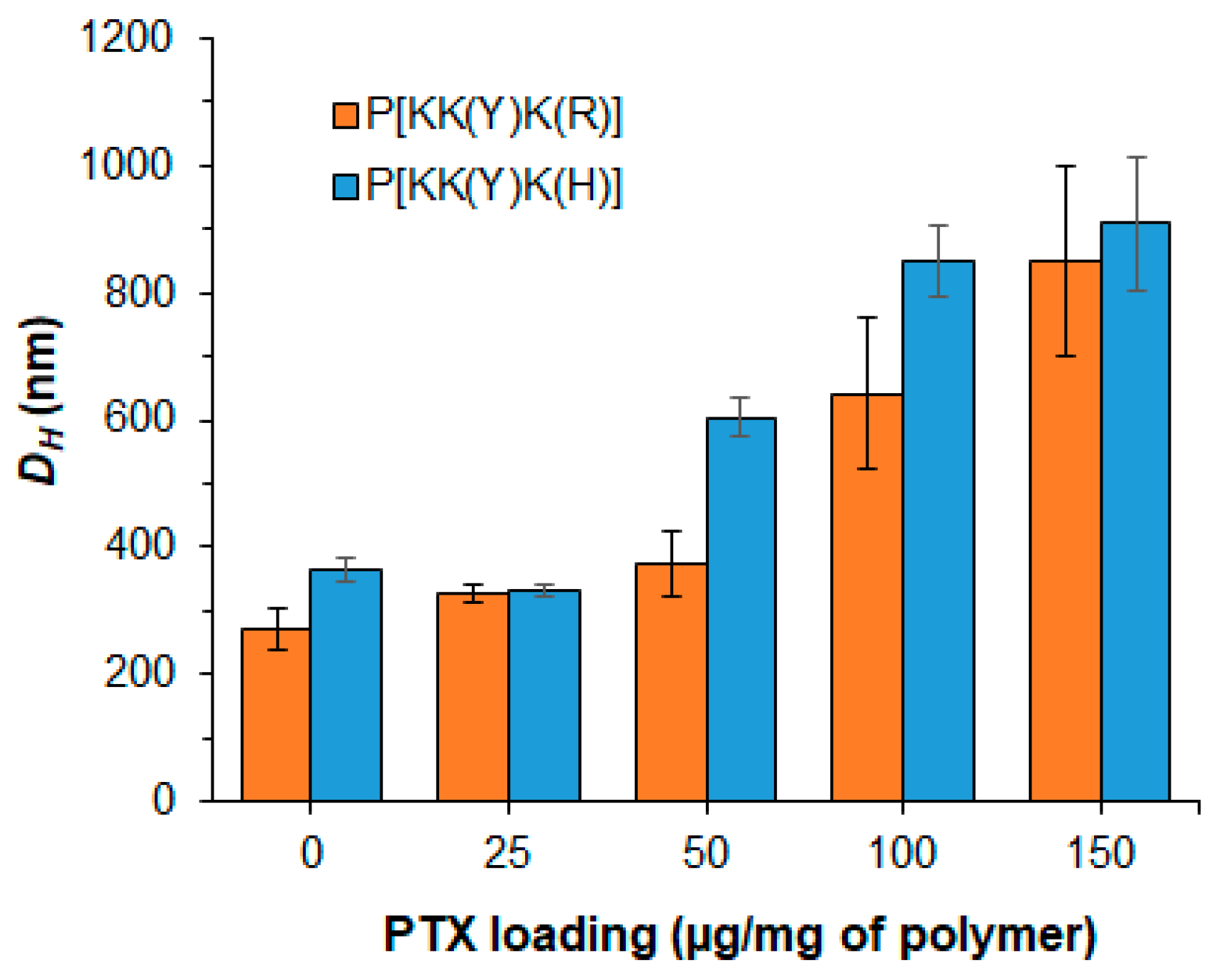
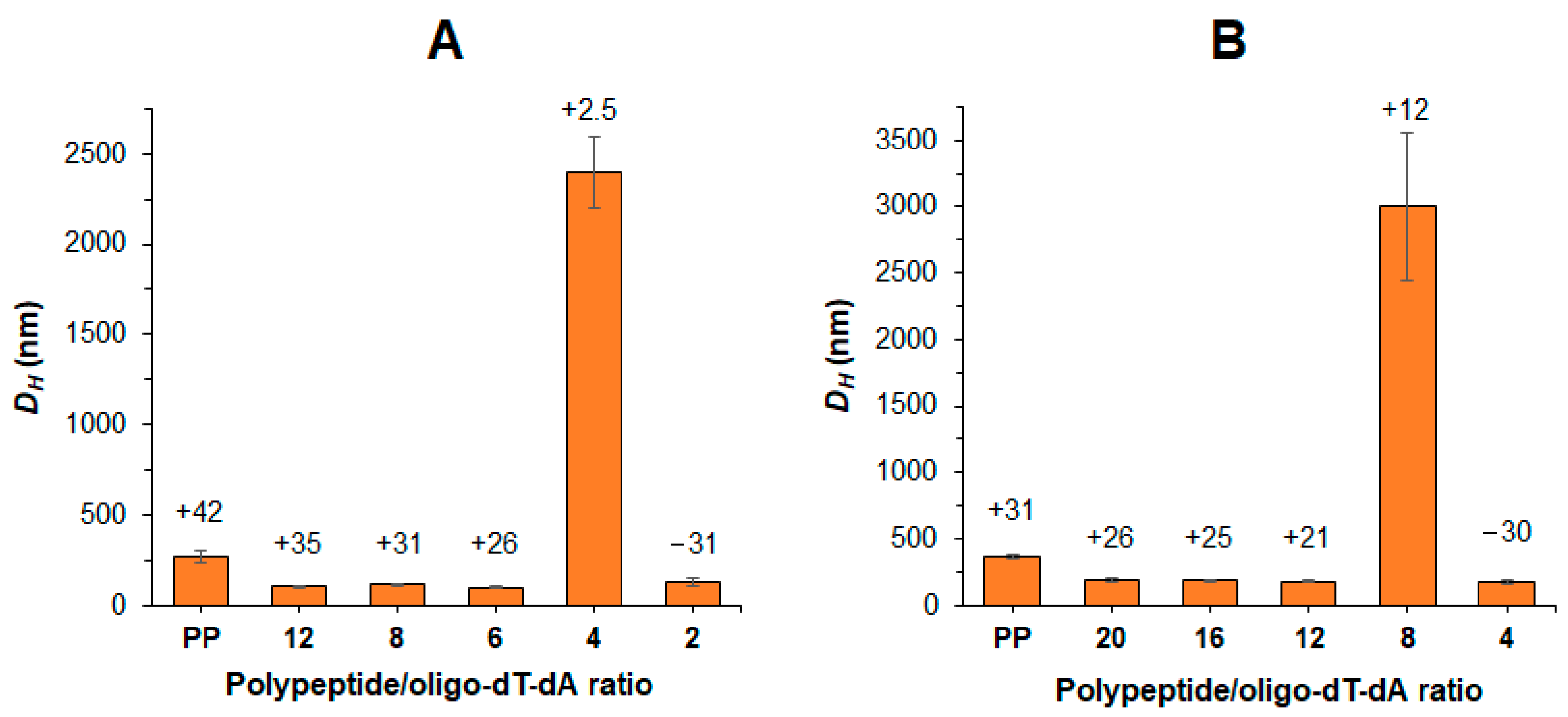

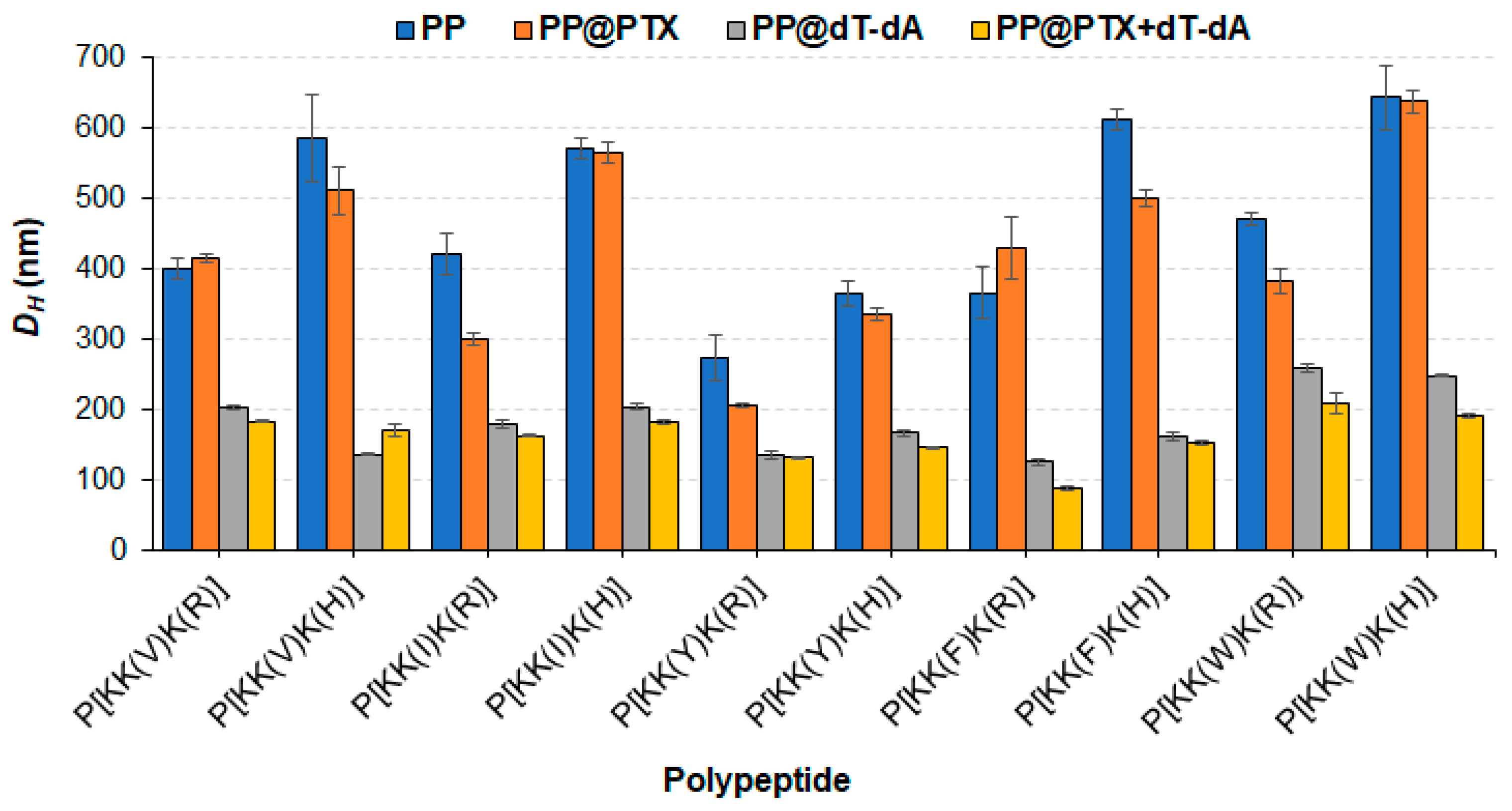

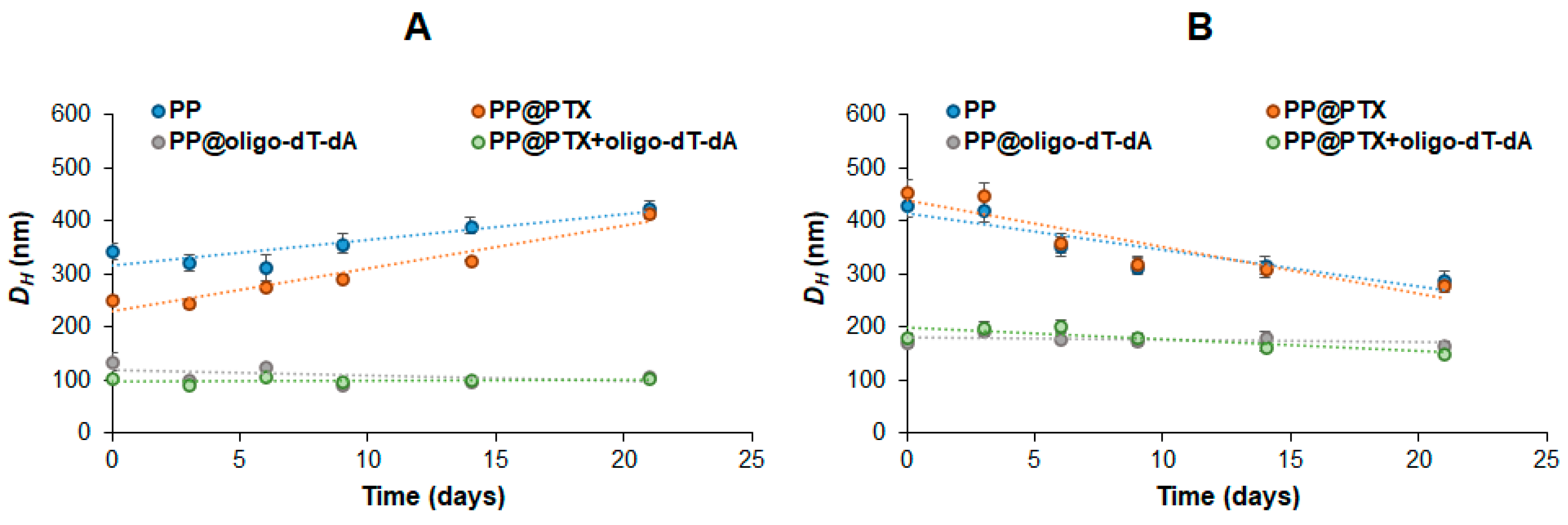
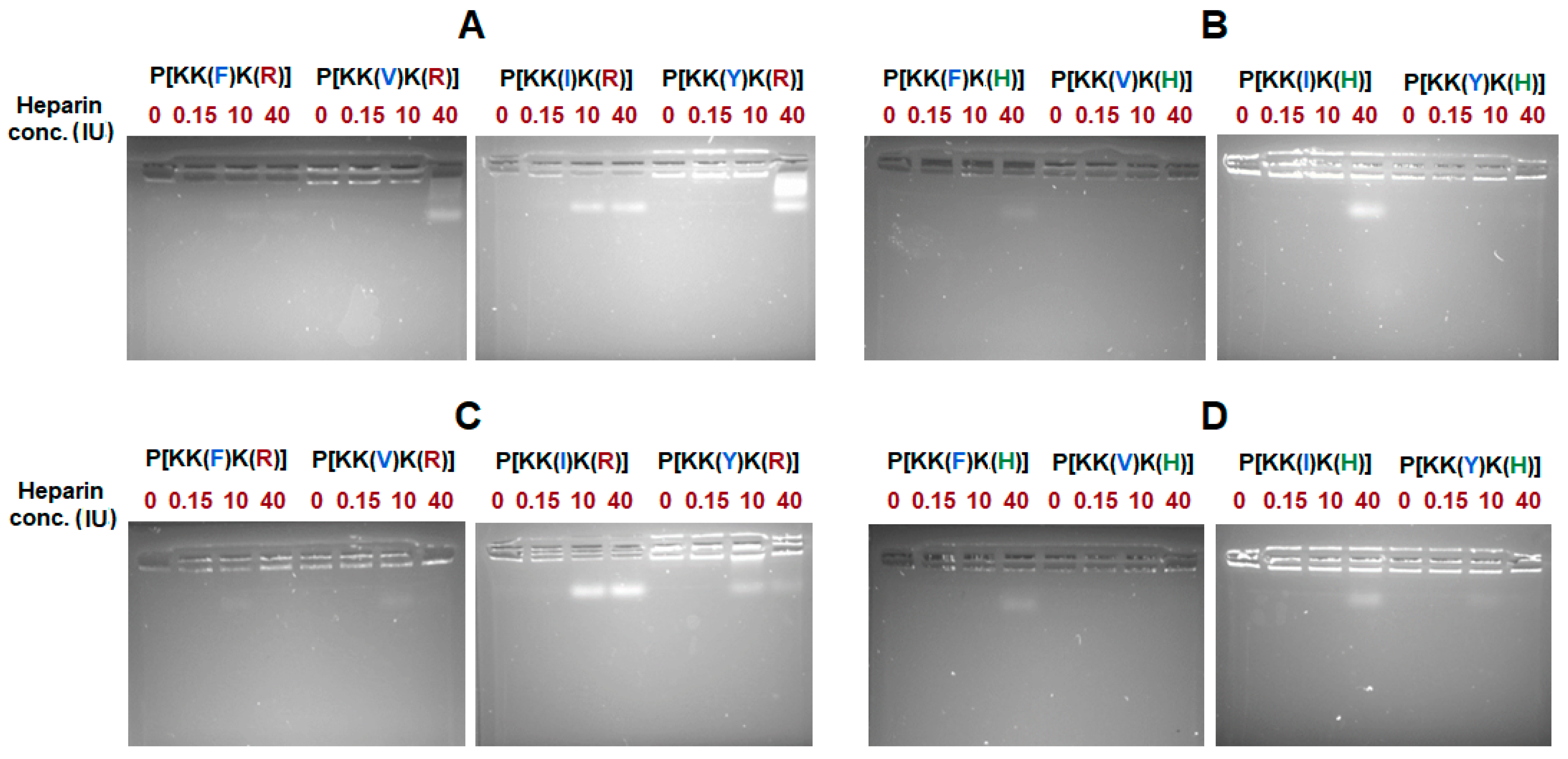
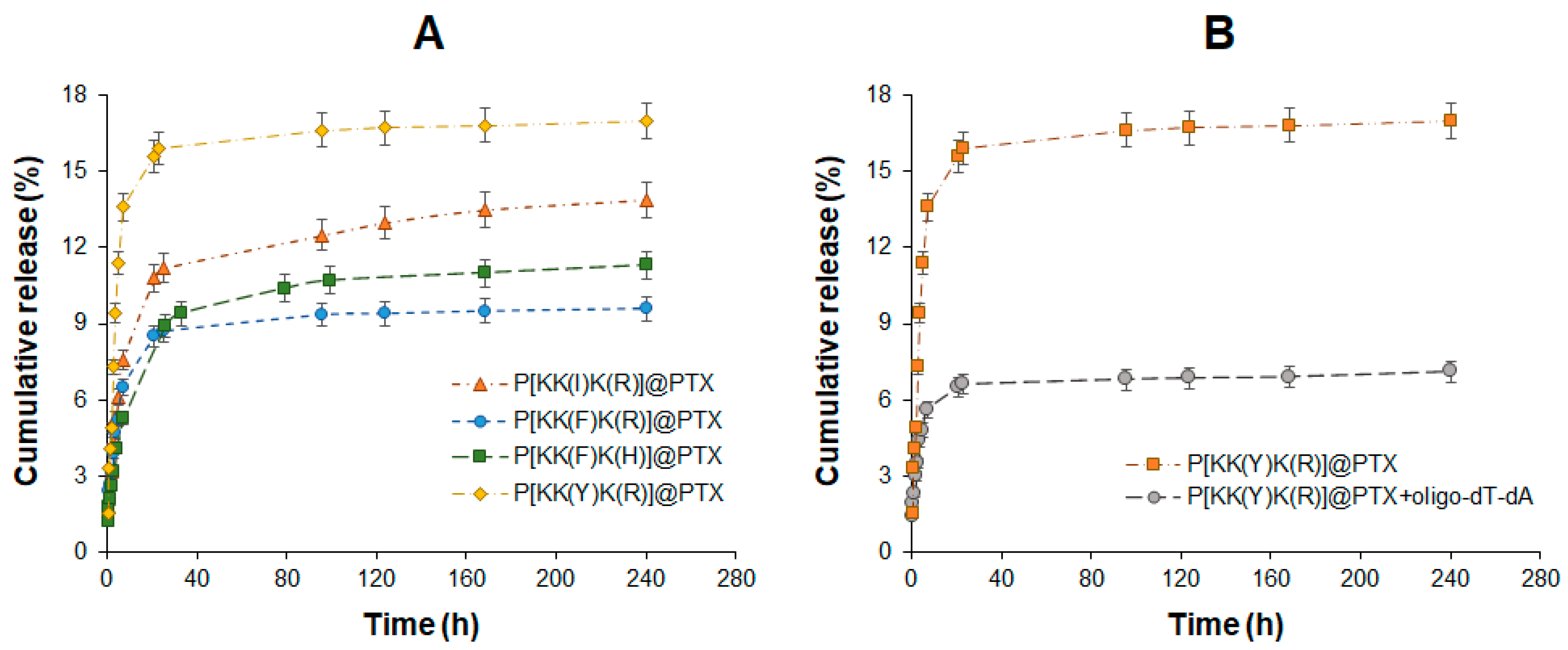
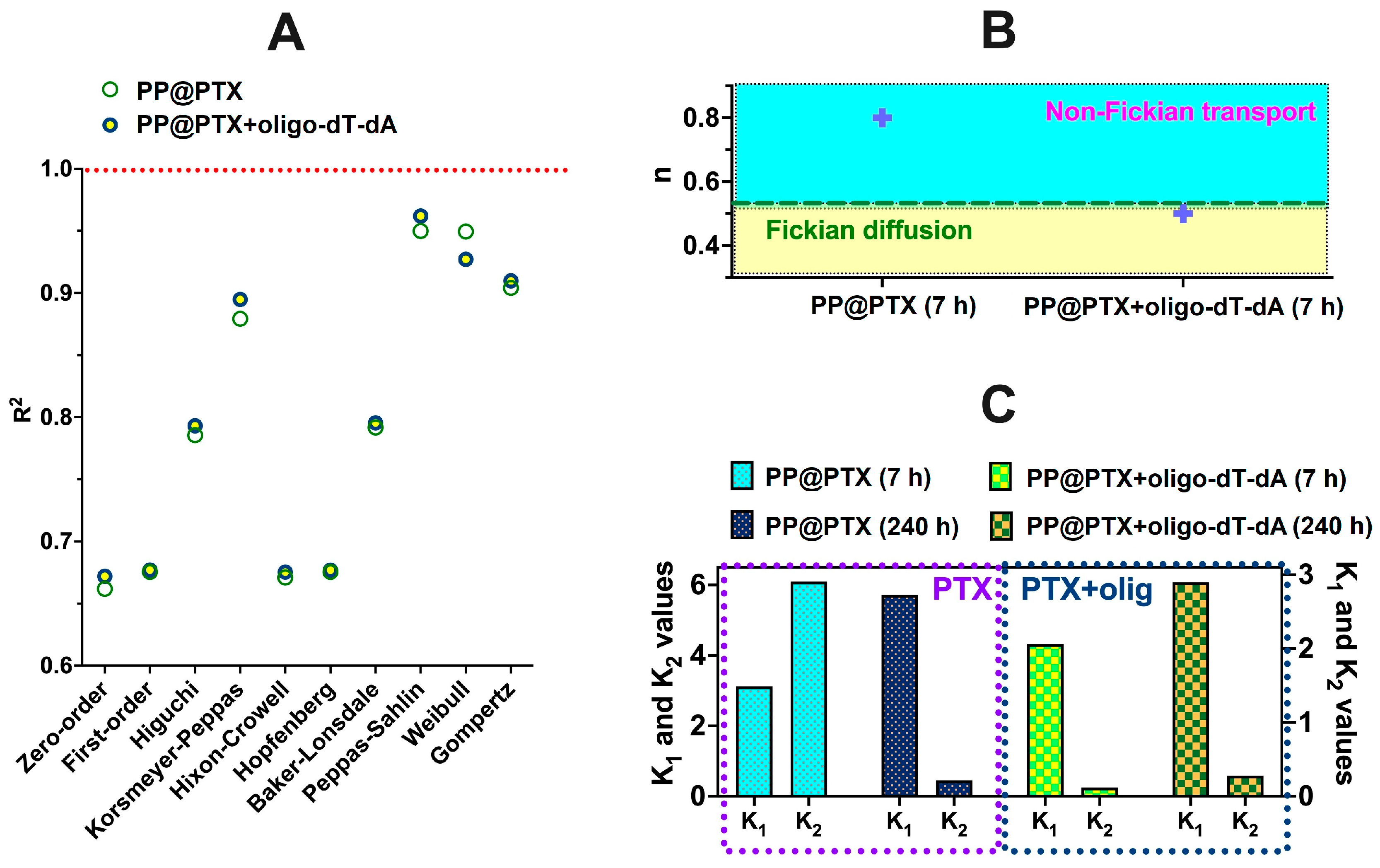
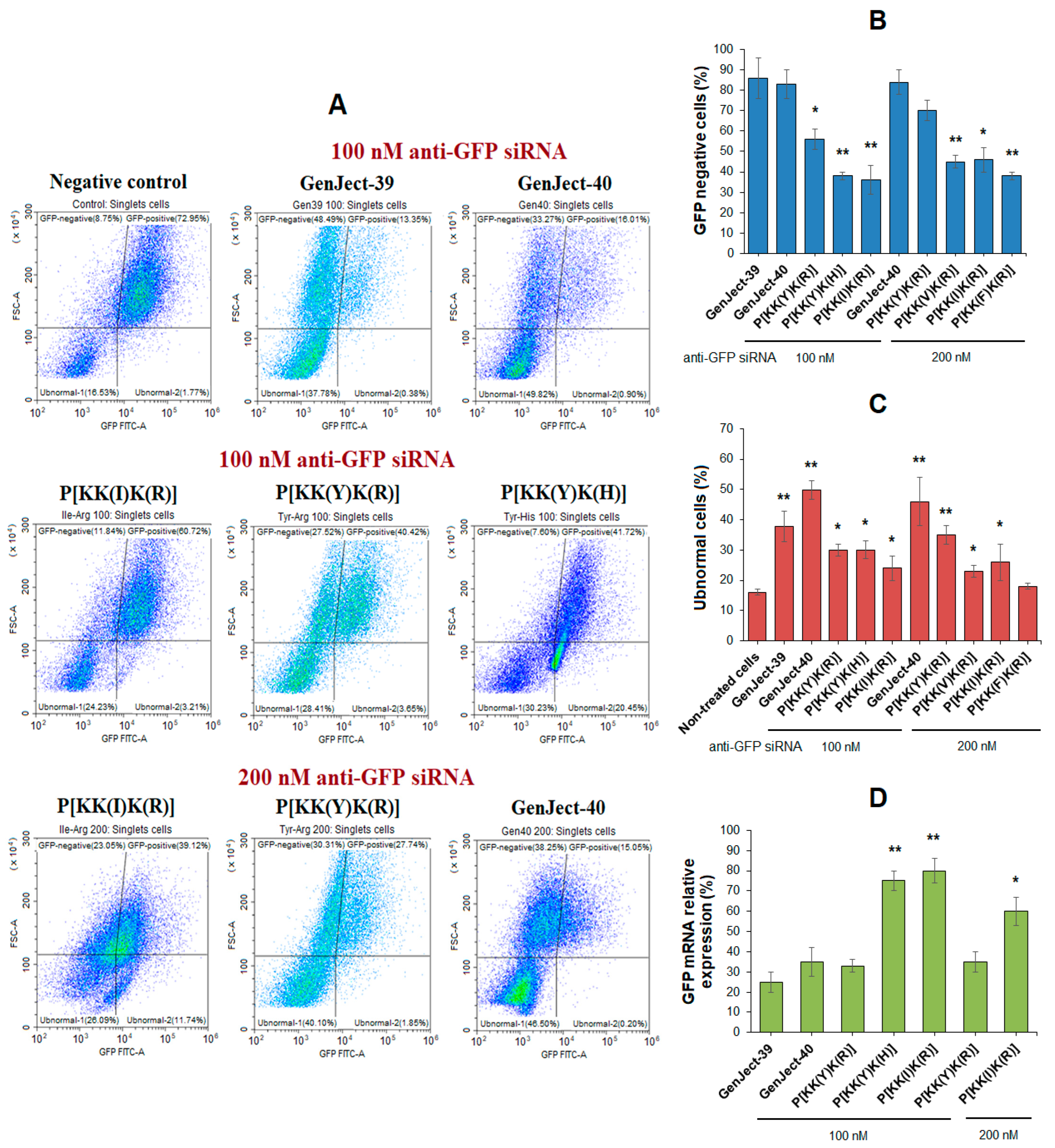
| Polymer | dn/dc a, cm3/g | Mw | A2 b, cm3·mol/g2 | Rh-D c, nm |
|---|---|---|---|---|
| P[K(Z)] | 0.1128 | 16,800 | 2.94 × 10−3 | 2.1 |
| P[KK(V)] | 0.1139 | 12,500 | 3.79 × 10−3 | 1.8 |
| P[KK(I)] | 0.1000 | 13,100 | 2.13 × 10−2 | 1.7 |
| P[KK(Y)] | 0.1342 | 14,000 | 5.34 × 10−4 | 1.2 |
| P[KK(F)] | 0.1151 | n/c e | n/c e | 0.8 d |
| Polymer a | Hydrophobic Amino Acid Content (mol%) | Arg/His Content (mol%), HPLC | Calculated Mn c | |||
|---|---|---|---|---|---|---|
| Amino Acid | 1H NMR | HPLC b | Arg | His | ||
| P[KK(V)K(R)] | Val | 21 | 26 | 39 | - | 19,890 |
| P[KK(V)K(H)] | - | 42 | 19,580 | |||
| P[KK(I)K(R)] | Ile | 25 | 25 | 32 | - | 19,390 |
| P[KK(I)K(H)] | - | 42 | 20,090 | |||
| P[KK(Y)K(R)] | Tyr | 16 | 16 | 35 | - | 19,620 |
| P[KK(Y)K(H)] | - | 43 | 20,020 | |||
| P[KK(F)K(R)] | Phe | 17 | 18 | 28 | - | 18,640 |
| P[KK(F)K(H)] | - | 43 | 20,050 | |||
| P[KK(W)K(R)] | Trp | 19 | - | 21 | - | 18,450 |
| P[KK(W)K(H)] | - | 41 | 20,630 | |||
| Model | Correlation Coefficients and Parameters | P[KK(F)K(R)]@PTX | P[KK(I)K(R)]@PTX | P[KK(F)K(H)]@PTX | |||
|---|---|---|---|---|---|---|---|
| 7 h | 240 h | 7 h | 240 h | 7 h | 240 h | ||
| Zero-order F = k0* t | R2 | 0.9955 | 0.7281 | 0.9968 | 0.7945 | 0.9858 | 0.7826 |
| k0 | 1.085 | 0.058 | 1.232 | 0.069 | 0.845 | 0.068 | |
| First-order F = 100 * [1 − Exp(−k1 * t)] | R2 | 0.9960 | 0.7357 | 0.9974 | 0.8046 | 0.9872 | 0.7940 |
| k1 | 7.5 × 10−3 | 6.3 × 10−4 | 9.7 × 10−3 | 9.0 × 10−4 | 8.7 × 10−3 | 7.5 × 10−4 | |
| Higuchi F = kH * t0.5 | R2 | 0.9957 | 0.8466 | 0.9915 | 0.8975 | 0.9991 | 0.9095 |
| kH | 2.345 | 0.871 | 2.625 | 1.184 | 1.883 | 0.983 | |
| Korsmeyer–Peppas F = kKP * tn | R2 | 0.9966 | 0.9249 | 0.9963 | 0.9497 | 0.9992 | 0.9583 |
| kKP | 2.227 | 3.504 | 2.158 | 3.807 | 1.757 | 2.826 | |
| n | 0.538 | 0.207 | 0.643 | 0.255 | 0.551 | 0.277 | |
| Hixon–Crowell F = 100 * [1 − (1 − kHC * t)3] | R2 | 0.9960 | 0.7332 | 0.9973 | 0.8012 | 0.9867 | 0.7902 |
| kHC | 3.7 × 10−3 | 2.0 × 10−4 | 4.2 × 10−3 | 2.9 × 10−4 | 2.8 × 10−3 | 2.4 × 10−4 | |
| Hopfenberg F = 100 * [1 − (1 − kHB * t)n] | R2 | 0.9963 | 0.7357 | 0.9975 | 0.8045 | 0.9871 | 0.7939 |
| kHB | 8.7 × 10−5 | 5.1 × 10−6 | 4.2 × 10−4 | 3.9 × 10−6 | 4.7 × 10−4 | 6.1 × 10−6 | |
| Baker–Lonsdale 3/2 * [1 − (1 − F/100)(2/3)] − F/100 = kBL * t | R2 | 0.9953 | 0.8497 | 0.9911 | 0.9011 | 0.9990 | 0.9129 |
| kBL | 9.4 × 10−5 | 1.3 × 10−5 | 11.2 × 10−4 | 3.5 × 10−5 | 6.0 × 10−5 | 1.7 × 10−5 | |
| Weibull F = 100 * {1 − Exp[−((t − Ti)β)/α]} | R2 | 0.9990 | 0.9432 | 0.9987 | 0.9616 | 0.9992 | 0.9683 |
| α | 61.154 | 25.591 | 23.529 | 5.71 | 56.679 | 31.695 | |
| β | 0.694 | 0.195 | 0.248 | 0.24 | 0.562 | 0.267 | |
| Gompertz F = 100 * Exp{−α * Exp[−β * log(t)]} | R2 | 0.9910 | 0.9406 | 0.9904 | 0.9656 | 0.9979 | 0.9737 |
| α | 3.815 | 3.423 | 3.869 | 3.392 | 4.063 | 3.716 | |
| β | 0.374 | 0.181 | 0.465 | 0.247 | 0.366 | 0.248 | |
| Peppas–Sahlin F = k1 * tm + k2 * t(2*m) | R2 | 0.9979 | 0.9785 | 0.9974 | 0.9815 | 0.9993 | 0.9925 |
| k1 | 1.654 | 3.115 | 1.546 | 3.290 | 1.789 | 2.256 | |
| k2 | 0.590 | 0.240 | 0.648 | 0.194 | 0.041 | 0.110 | |
| m | 0.400 | 0.397 | 0.458 | 0.431 | 0.578 | 0.466 | |
| Polypeptide Particles | IC50 (µg/mL) | ||
|---|---|---|---|
| HEK 293T | HeLa | A549 | |
| P[KK(V)K(R)] | - | 71 ± 14 | 25 ± 3 |
| P[KK(V)K(H)] | 254 ± 44 | 92 ± 23 | 48 ± 6 |
| P[KK(I)K(R)] | - | 57 ± 3 | 28 ± 4 |
| P[KK(I)K(H)] | 233 ± 48 | 83 ± 13 | 93 ± 9 |
| P[KK(Y)K(R)] | 134 ± 28 | 55 ± 12 | 47 ± 8 |
| P[KK(Y)K(H)] | 183 ± 16 | 55 ± 7 | 57 ± 13 |
| P[KK(F)K(R)] | - | 88 ± 13 | 58 ± 9 |
| P[KK(F)K(H)] | 234 ± 38 | 118 ± 22 | 90 ± 18 |
| P[KK(W)K(R)] | 289 ± 88 | - | 69 ± 8 |
| P[KK(W)K(H)] | 306 ± 95 | - | 134 ± 19 |
| System | IC50 (ng/mL) |
|---|---|
| A549 | |
| Free PTX | 5.1 ± 1.9 |
| P[KK(I)K(R)]@PTX | 6.2 ± 2.3 * |
| P[KK(I)K(H)]@PTX | 4.7 ± 0.5 * |
| P[KK(Y)K(R)]@PTX | 4.9 ± 1.5 * |
| P[KK(Y)K(H)]@PTX | 4.4 ± 0.6 * |
| P[KK(F)K(H)]@PTX | 5.6 ± 1.2 * |
| P[KK(W)K(H)]@PTX | 4.5 ± 1.6 * |
Disclaimer/Publisher’s Note: The statements, opinions and data contained in all publications are solely those of the individual author(s) and contributor(s) and not of MDPI and/or the editor(s). MDPI and/or the editor(s) disclaim responsibility for any injury to people or property resulting from any ideas, methods, instructions or products referred to in the content. |
© 2023 by the authors. Licensee MDPI, Basel, Switzerland. This article is an open access article distributed under the terms and conditions of the Creative Commons Attribution (CC BY) license (https://creativecommons.org/licenses/by/4.0/).
Share and Cite
Dzhuzha, A.; Gandalipov, E.; Korzhikov-Vlakh, V.; Katernyuk, E.; Zakharova, N.; Silonov, S.; Tennikova, T.; Korzhikova-Vlakh, E. Amphiphilic Polypeptides Obtained by Post-Polymerization Modification of Poly-l-Lysine as Systems for Combined Delivery of Paclitaxel and siRNA. Pharmaceutics 2023, 15, 1308. https://doi.org/10.3390/pharmaceutics15041308
Dzhuzha A, Gandalipov E, Korzhikov-Vlakh V, Katernyuk E, Zakharova N, Silonov S, Tennikova T, Korzhikova-Vlakh E. Amphiphilic Polypeptides Obtained by Post-Polymerization Modification of Poly-l-Lysine as Systems for Combined Delivery of Paclitaxel and siRNA. Pharmaceutics. 2023; 15(4):1308. https://doi.org/10.3390/pharmaceutics15041308
Chicago/Turabian StyleDzhuzha, Apollinariia, Erik Gandalipov, Viktor Korzhikov-Vlakh, Elena Katernyuk, Natalia Zakharova, Sergey Silonov, Tatiana Tennikova, and Evgenia Korzhikova-Vlakh. 2023. "Amphiphilic Polypeptides Obtained by Post-Polymerization Modification of Poly-l-Lysine as Systems for Combined Delivery of Paclitaxel and siRNA" Pharmaceutics 15, no. 4: 1308. https://doi.org/10.3390/pharmaceutics15041308
APA StyleDzhuzha, A., Gandalipov, E., Korzhikov-Vlakh, V., Katernyuk, E., Zakharova, N., Silonov, S., Tennikova, T., & Korzhikova-Vlakh, E. (2023). Amphiphilic Polypeptides Obtained by Post-Polymerization Modification of Poly-l-Lysine as Systems for Combined Delivery of Paclitaxel and siRNA. Pharmaceutics, 15(4), 1308. https://doi.org/10.3390/pharmaceutics15041308










